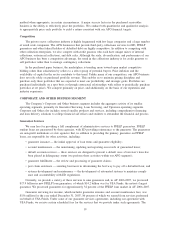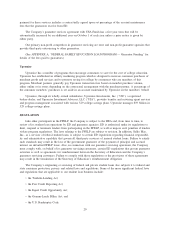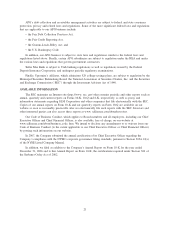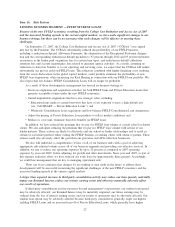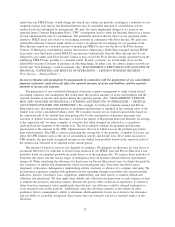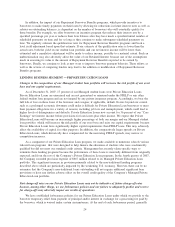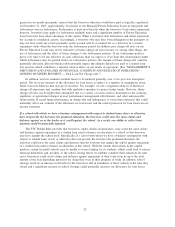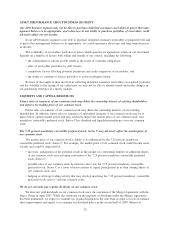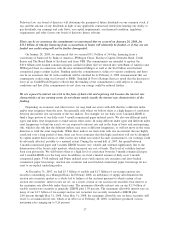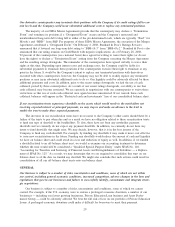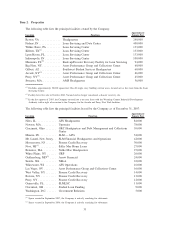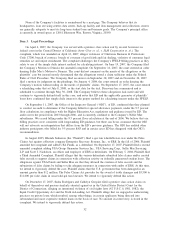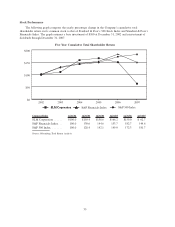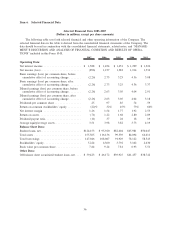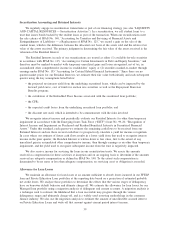Sallie Mae 2007 Annual Report Download - page 30
Download and view the complete annual report
Please find page 30 of the 2007 Sallie Mae annual report below. You can navigate through the pages in the report by either clicking on the pages listed below, or by using the keyword search tool below to find specific information within the annual report.Our derivative counterparties may terminate their positions with the Company if its credit ratings fall to cer-
tain levels and the Company could incur substantial additional costs to replace any terminated positions.
The majority of our ISDA Master Agreements provide that the counterparty may declare a “Termination
Event” and terminate its positions if a “Designated Event” occurs and the Company’s unsecured and
unsubordinated long-term debt rating fall to either of the pre-determined levels, which are typically “Baa3” for
Moody’s and “BBB-” from S&P. For purposes of these ISDA Master Agreements, the execution of the Merger
Agreement constituted a “Designated Event.” On February 4, 2008, Standard & Poor’s Ratings Services
announced that it lowered our long-term debt rating to “BBB-/A-3” from “BBB+/A-2.” Standard & Poor’s also
announced that our rating remains on CreditWatch with negative implications. As of February 28, 2008,
92 percent of the counterparties (on a notional basis) have agreed in writing to waive their rights (or do not
have the rights) to declare a “Termination Event” arising from the Company executing the Merger Agreement
and the resulting ratings downgrade. The remainder of the counterparties have agreed verbally to waive their
rights at this time. Depending upon interest rates and exchange rates, the Company could be liable for
substantial payments to terminate these positions if the counterparties exercise their right to terminate at any
point in the future. It would be the Company’s intent to replace any terminated positions with derivatives
executed with other counterparties, however, the Company may not be able to readily replace any terminated
positions or may incur substantial additional costs to do so. Our liquidity could be adversely affected by these
additional payments and costs. In addition, prior to the recent ratings downgrade, we had the use of cash
collateral posted by these counterparties. As a result of our recent ratings downgrade, our ability to use that
cash collateral may become restricted. We are currently in negotiations with our counterparties to waive these
restrictions so that use of such cash collateral once again becomes unrestricted. If not waived, these cash
collateral balances will appear in the “Restricted cash and investments” line of our consolidated balance sheet.
If our securitization trusts experience shortfalls on the assets which would result in the noteholders not
receiving expected interest or principal payments, we may step in and make an advance to the trust to
enable the trust to make these expected payments.
The investors in our securitization trusts have no recourse to the Company’s other assets should there be a
failure of the trusts to pay when due and as a result we have no obligation related to these securitization trusts
to fund any type of shortfall to the bondholders. To date, there have not been any noteholder payment
shortfalls and we currently do not expect any payment shortfalls. In addition, we currently do not have any
intent to fund shortfalls that might arise. We may decide, however, that it is in the best interest of the
Company to fund any such shortfall. For example, by funding any shortfalls it may make it more cost effective
to issue new securitizations in the future. Funding any shortfalls would reduce the amount of cash and liquidity
we have on balance sheet and could result in a loss and reduction of equity as well. In addition, if we funded
a shortfall related to an off-balance sheet trust, we would re-examine our accounting treatment to determine
whether the trust would still be considered a “Qualified Special Purpose Entity” under SFAS No. 140,
“Accounting for Transfers and Servicing of Financial Assets and Extinguishments of Liabilities — a Replace-
ment of SFAS No. 125.” As a result, we may determine that we are required to consolidate that trust on our
balance sheet as of the date we funded any shortfall. We might also conclude that such actions could result in
consolidation of all our off-balance sheet trusts onto our balance sheet.
GENERAL
Our business is subject to a number of risks, uncertainties and conditions, some of which are not within
our control, including general economic conditions, increased competition, adverse changes in the laws and
regulations that govern our businesses and failure to successfully identify, consummate and integrate strate-
gic acquisitions.
Our business is subject to a number of risks, uncertainties and conditions, some of which we cannot
control. For example, if the U.S. economy were to sustain a prolonged economic downturn, a number of our
businesses — including our fastest growing businesses, Private Education Loan business and Asset Perfor-
mance Group — could be adversely affected. We bear the full risk of loss on our portfolio of Private Education
Loans. A prolonged economic downturn could make it difficult for borrowers to meet their payment
29


